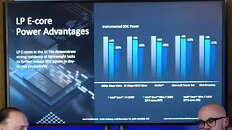- Joined
- Oct 9, 2007
- Messages
- 47,430 (7.51/day)
- Location
- Hyderabad, India
| System Name | RBMK-1000 |
|---|---|
| Processor | AMD Ryzen 7 5700G |
| Motherboard | ASUS ROG Strix B450-E Gaming |
| Cooling | DeepCool Gammax L240 V2 |
| Memory | 2x 8GB G.Skill Sniper X |
| Video Card(s) | Palit GeForce RTX 2080 SUPER GameRock |
| Storage | Western Digital Black NVMe 512GB |
| Display(s) | BenQ 1440p 60 Hz 27-inch |
| Case | Corsair Carbide 100R |
| Audio Device(s) | ASUS SupremeFX S1220A |
| Power Supply | Cooler Master MWE Gold 650W |
| Mouse | ASUS ROG Strix Impact |
| Keyboard | Gamdias Hermes E2 |
| Software | Windows 11 Pro |
Intel on Wednesday held a pre-launch round-table with HotHardware, in which it made several performance disclosures of its upcoming Core "Meteor Lake" mobile processor, comparing it with the current U-segment chips based on the 13th Gen Core "Raptor Lake," and competing AMD Ryzen 7040 "Phoenix." In these, the company is claiming that its next-generation iGPU based on the Xe-LPG graphics architecture, armed with 128 EU, is significantly outperforming the Radeon 780M RDNA3 iGPU of the Ryzen 7040, while its CPU is ahead in multi-threaded performance.
In its comparison, the company picked the Core Ultra 7 165H, a middle-of-the-market performance segment part in the 28 W class. This is compared to the Core i7-1370P "Raptor Lake," and the AMD Ryzen 7 7840U. The company also dropped in the fastest Windows-ready Arm chip in the market, the Qualcomm 8cx Gen 3. In the 33 games that the 165H was compared to the 7840U, the Intel iGPU is shown posting performance leads ranging between 3% to 70% over the Radeon 780M, in 23 out of 33 games. In one of the games, the two perform on par with each other. In 9 out of 33 games, the Radeon 780M beats the Intel Xe-LPG by 2% to 18%. The iGPU of the 165H packs 8 Xe cores, or 128 EU (1,024 unified shaders). The Radeon 780M is powered by 12 RDNA3 compute units (768 stream processors).




The Core Ultra 7 165H is a 16-core/22-thread processor, with 6 P-cores, 8 E-cores, and 2 L-cores (low-power island cores). The company put out a selection of multi-threaded CPU performance benchmarks, where it compared the chip to an i7-1370P (6P+8E), and the 7840U (8-core). In its benchmarks, Intel claims that the 165H is an average of 11% faster than the 7840U, and 9% faster than the i7-1370P, which is claimed to be 2% faster than the 7840U. All three chips are claimed to be of a similar power class, catering to the same category of thin-and-light notebooks.
Intel also demonstrated the power management benefits of the 2 low-power island cores in the SoC tile of the "Meteor Lake." The hardware scheduler of the processor is programmed to direct processing load to these cores first, and depending on their performance demand, upgrade them to the E-cores of the Compute tile, and then onward to the P-cores. When idling or with very low performance demand, all background tasks are relegated to the LP island cores, allowing the processor to clock-gate the Compute tile. This results in power savings ranging anywhere between 8% to 35%. Intel considers tasks such as video playback on online streaming services, or web-browsing, as workloads that can be relegated to the LP island cores for such power savings.
View at TechPowerUp Main Site | Source
In its comparison, the company picked the Core Ultra 7 165H, a middle-of-the-market performance segment part in the 28 W class. This is compared to the Core i7-1370P "Raptor Lake," and the AMD Ryzen 7 7840U. The company also dropped in the fastest Windows-ready Arm chip in the market, the Qualcomm 8cx Gen 3. In the 33 games that the 165H was compared to the 7840U, the Intel iGPU is shown posting performance leads ranging between 3% to 70% over the Radeon 780M, in 23 out of 33 games. In one of the games, the two perform on par with each other. In 9 out of 33 games, the Radeon 780M beats the Intel Xe-LPG by 2% to 18%. The iGPU of the 165H packs 8 Xe cores, or 128 EU (1,024 unified shaders). The Radeon 780M is powered by 12 RDNA3 compute units (768 stream processors).




The Core Ultra 7 165H is a 16-core/22-thread processor, with 6 P-cores, 8 E-cores, and 2 L-cores (low-power island cores). The company put out a selection of multi-threaded CPU performance benchmarks, where it compared the chip to an i7-1370P (6P+8E), and the 7840U (8-core). In its benchmarks, Intel claims that the 165H is an average of 11% faster than the 7840U, and 9% faster than the i7-1370P, which is claimed to be 2% faster than the 7840U. All three chips are claimed to be of a similar power class, catering to the same category of thin-and-light notebooks.
Intel also demonstrated the power management benefits of the 2 low-power island cores in the SoC tile of the "Meteor Lake." The hardware scheduler of the processor is programmed to direct processing load to these cores first, and depending on their performance demand, upgrade them to the E-cores of the Compute tile, and then onward to the P-cores. When idling or with very low performance demand, all background tasks are relegated to the LP island cores, allowing the processor to clock-gate the Compute tile. This results in power savings ranging anywhere between 8% to 35%. Intel considers tasks such as video playback on online streaming services, or web-browsing, as workloads that can be relegated to the LP island cores for such power savings.
View at TechPowerUp Main Site | Source





 oh dear!
oh dear!

